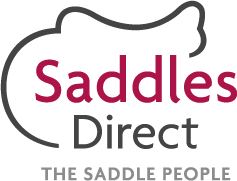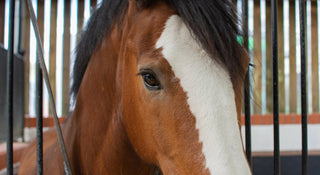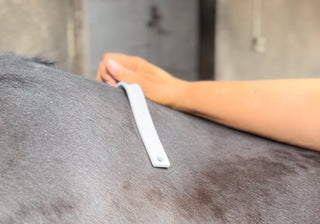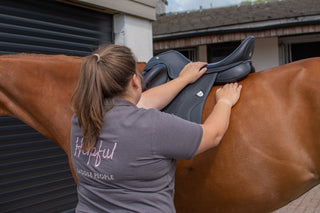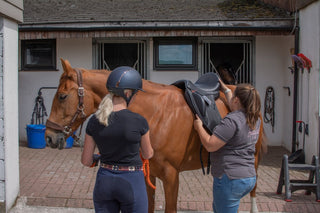Often when riders reach out, they already suspect that something is not quite right. It's a gut feeling, an intuition built on the bond between horse and rider. And you know what? That’s perfectly okay. It’s a testament to the love and care we have for our horses; we only want them to be happy, comfortable, and confident in their work.
So, how can you tell if your horse isn’t quite happy? Perhaps you've heard phrases like, 'Oh, he always moves like that', or 'This saddle fits everything!', or even 'He never complains.' But, horses do communicate their discomfort, albeit in their own subtle ways.
It’s always right to ask, to seek advice, that’s why for this blog post, we’ll be sharing the signs of discomfort that could point towards saddle-related issues. Our aim is to empower you with knowledge to understand your horse better, and ultimately, to ensure their wellbeing. So, let’s kick on!
These are the top behavioural signs to look out for that your saddle may be causing discomfort:
- Flinching or moving away: This can be a sign of discomfort in the horse's back or shoulders.
- Tail shaking or pawing at the ground: These can be signs of stress or discomfort, especially when adjusting the girth.
- Muscle spasms or contractions: This can indicate that the horse is trying to avoid pain or pressure.
- Hollowing out: This is usually a reaction to avoid pain and discomfort, from uneven pressure points caused by the saddle.
- Rushing off when mounting: This may suggest that the saddle is causing discomfort.
- Snapping at the bit and reins: This could indicate that your horse is uncomfortable.
- Sinking as you get on: This could be a sign of pain or discomfort.
- A runny poo, swishing tail, sour face, or protruding nose: These could all be signs of discomfort.
- Rushed breathing, big sighs or snorts: These might indicate anxiety or discomfort. Or signs of relief whilst cooling down, slackening the girth could suggest that your horse was uncomfortable during the workout.
- Short, stuttery stride: This could be a sign of discomfort in the saddle.
- Uneven tracking up: If one side of your horse's hindquarters dips more than the other or if it reaches more with one hind leg, it could be a sign of saddle discomfort.
- Saddle swinging or kicking out: These are signs that the saddle might be too wide, the tree is the wrong shape, or one hind leg is working harder than the other.
- Hollowing out or disunited back legs in canter: If your horse hollows out its back or its back legs are not moving in unison, it might be feeling saddle discomfort.
- Extra footfall or skip on corners: This could indicate your horse is trying to avoid sore pressure points caused by the saddle.
But how do you check and look for these things? Next, we’ll go into more detail about how you can check for these things; what to feel for on the ground and things to look out for whilst tacking up, mounting and riding of course.
How to feel a horses back for soreness from a saddle
Start with the horse standing nice and square, head straight and no distractions such as a haynet. If you need a second pair of hands to achieve this, grab a helper.
Step 1: Feel along the spine
Standing on the near side, hold the horse's withers with your left hand. Stroke and scratch a bit to make the horse comfortable
With your right hand, make a fist and run your knuckles along the horse's spine, a couple of inches out from the spine where the saddle panel sits. Start from the withers and move towards the T18 area, which is the last vertebrae that has movement.
To find the T18 feel for the last rib and follow it up to the spine. That is your fit barrier, no saddles past here!
Press quite firmly and watch for any signs of discomfort such as flinching, trying to move away, tail shaking, pawing the ground, or sticking the nose up and out. Watch the horse's back for any spasms or contractions in the muscles. Hollowing out can indicate discomfort.
Horses do wiggle into a comfy spot and if the saddle is fitted correctly it will be balanced and secure, if not the muscle build up will be uneven and soreness will occur.
It could also be due to a way of going which has led the horse tensing on one side, lameness for example, in either case a physio can help. Do both sides and make a note of the reactions.
Step 2: Check the shoulders
Feel up and along the shoulder blade and round the scapula. Press deep into the rounded area near the top. Look for similar signs of discomfort as you observed in the back.
Pain here could mean the saddle is coming forward and blocking that motion. It could be too narrow; it could be too wide and dropping down with no pommel clearance putting pressure on the withers.
Step 3: Test the core muscles
When the horse is standing, scratch their belly and feel for the ridge along the middle. Gently push with your middle finger knuckle along this ridge and watch for the back rising or the horse kicking with its hind legs (not all horse’s like this test particularly).
Go to your horse’s rear, feel and let them know you’re there and then push a knuckle into the line running from its bottom to the top of the thigh area. Do they tense in their flank and behind the ribs? This shows they use their core and means they can round nicely into their saddle and are quite athletic. Do both sides.
Remember, no one knows your horse better than you do, so if you think something is not right or anything changes in your horse’s behaviour, it’s time to call a saddle fitter. Now, let’s move on to tacking up.
Identifying an ill-fitting saddle whilst tacking up & mounting
As you put the saddle pad on, then the saddle, attach the girth moving up one or two holes at a time ensuring the saddle doesn’t twist across the spine.
Look closely for changes in your horse's reaction at each stage, do they start pawing the ground or let you tack up without fuss? Any signs of discomfort, like a swishing tail, sour face, or protruding nose, could suggest saddle discomfort.
Signs when Mounting
Take note of your horse's behaviour while mounting. Does it stand nicely? One of the many reasons it’s essential for your horse to stand nicely. Pay attention to any adverse reactions such as rushing off, snapping at the bit and reins, or sinking as you get on.
Try to always use a mounting block instead of mounting from the ground. This is far better for the horse and the saddle.
Signs when Walking off & Warming up
Once you're mounted, notice your horse's breathing as it starts to walk. Are there big sighs or does it seem to be rushing its breaths? Look for signs of anxiety such as flicking ears or swishing tail, which may indicate discomfort. These behaviours could also be a reaction of wanting to go and excitement, so you’re looking for anything out of the ordinary.
Allow your horse to stretch if possible. Keep it moving and let its nose reach towards the ground, encouraging a good stretch.
A note about young horses
Pain & discomfort, especially early on, can cause a horse to display behaviours even once the pain is gone. Pain memory can show up across many areas of horse care and it is so important to plan and prepare for your horse, to ensure they will be happy and comfortable in training.
If you send a young horse away for education, some trainers may use a breaking saddle that is used across all the youngsters on the yard. We strongly recommend having your youngster fitted for a saddle before they go, and even send them with one to prevent any negative associations being formed early on. That way, you at least have a point of reference from a saddle perspective.
Ridden Signs of Saddle Discomfort
After warming up, observe how your horse is tracking. Ask someone to watch from behind in a straight line. Is one side dipping more than the other? Is your horse reaching more with one hind leg than the other?
A physio will be able to help, but it could be that the saddle swings too much at the back. If the saddle is too wide, it could make the front point downwards and not make contact across all the back which would usually result in tension or pain through the shoulders.
Look at how the saddle behaves when your horse is moving. Does it swing too much at the back? Does it kick out on one side? This could be stride related, one hind leg working harder than the other will push the saddle over in a kick out motion.
Trot
Observe your horse's behaviour when trotting. Are there any signs of discomfort, such as a protruding nose, flicking ears, or swishing tail? Look out for other signs such as the horse sticking its tongue out, grinding teeth, rolling eyes, or making an unusual face.
Canter
Pay attention to your horse's behaviour when cantering. Does it hollow out or seem disunited in its back legs? Do they throw in an extra footfall, like a skip, especially on corners? These could all be signs that the saddle is causing discomfort.
Cool down
After the workout, ensure your horse has time to cool down. Allow it to stretch and look out for any signs of relief, such as deep sighs or snorts.
Always keep an eye out for any signs of discomfort and consult a professional if you're unsure. It's essential to consider the role of other equine care experts, such as physiotherapists, farriers, vets, and dentists, in identifying the root of any discomfort.
Don’t forget to check the rest of your tack
Girth
If your girth only has elastic on one side, this could result in an uneven effect on your horse's shoulders and wither area. The saddle will consistently lean towards the elastic side, and you may find yourself unconsciously trying to correct this by putting more weight in the opposite stirrup to pull the saddle back over... and that can't be comfortable for either of you!
Instead, consider using a girth with robust 3-ply elastic on both sides, or none at all. You could als consider an Anatomical Girth, which have elastic on both sides and is shaped to reduce pressure and sore points. We’ve produced a whole guide on anatomical girths to help you decide.
We understand that sometimes we have to make do and manage our budget. So, if you do have a single-sided elastic girth, try swapping it over every other time you use it. Your horse will certainly appreciate the effort!
Stirrup Leathers
If you're using the traditional, thicker leather stirrups it's a good idea to swap them over every month. It's natural for one to stretch and become longer than the other due to our inherent tendency to favour one side. Whether caused by the horse's movement or rider habits, this unevenness can lead to disproportionate muscle build-up on one side. So remember, give them a swap around periodically!
Bridle
The source of the problem could be something as straightforward as a browband that's too tight, a common issue that often leads to head shaking or pinched ears. You should be able to comfortably slip a couple of fingers under your horse's browband.
If it's too tight, or if the bit straps are too short, your horse may display these signs of discomfort. Thankfully, it's an easily rectifiable issue! Indeed, ensuring the comfort and happiness of our horses often comes down to attention to the simplest of details.
If in doubt, call an expert.
Asking is always OK and costs nothing, we are here to help in our office for all things saddles, giving advice over the phone and email.
Navigating the world of tack and saddle fitting isn't always a doddle. Ensuring your horse has a properly fitting saddle is one of the most vital aspects of creating and nurturing a bond with your horse. It's one less thing to worry about, freeing us up to enjoy more time riding.
We genuinely hope you've found this guide handy. We’ve intentionally tried to keep the tone light-hearted and jargon-free, we know our audience is diverse; some are new to the horse world, some young, and some of you might already be well-versed in this arena! But, a refresher never hurts.
As horse owners, we all share the common goal of wanting the best for our horses. We desire their happiness in their work and their comfort and confidence in the tack we use. After all, it makes us better riders and forms a stronger team.
Until then, keep observing, keep caring, and remember, no one knows your horse better than you do. Here's to happy riding and comfortable saddles!
